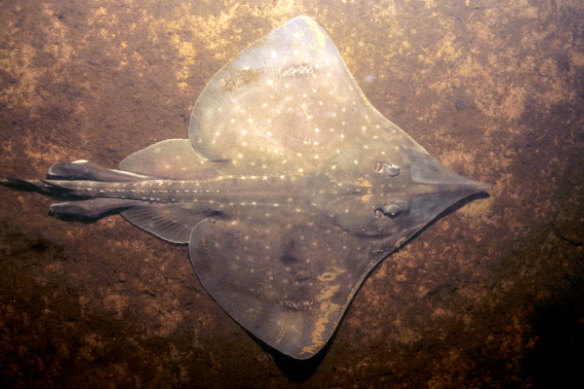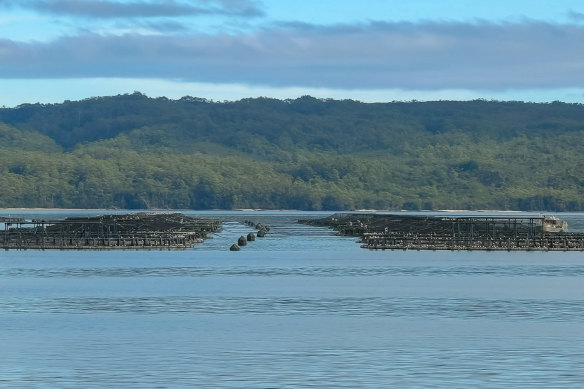Save articles for later
Add articles to your saved list and come back to them any time.
Over 100 million years, the Maugean skate has evolved to live in the dark, tannin-rich waters of Macquarie Harbour, a fjord-like estuary on the remote west coast of Tasmania.
But this Gondwanan relic, dubbed the “thylacine of the sea”, is now on the brink of extinction. A federal conservation plan released this week found industrial fish farming and no changes to hydroelectric dam flows into Macquarie Harbour – the only place the species survives – will have a “catastrophic” effect on the skate’s dwindling population.
The Maugean skate is on the brink of extinction.Credit: Neville Barrett
Conservation groups are calling for Australia’s major supermarkets – Coles, Woolworths and Aldi – to halt the sale of farmed salmon from Macquarie Harbour to prevent the extinction of the endangered skate. Salmon aquaculture is the primary cause of reduced levels of dissolved oxygen in the harbour.
“Woolworths, Coles and Aldi have an extinction on their hands – they are selling a product that is killing one of Australia’s rare and unique animals,” said Alistair Allan, a marine campaigner at the Bob Brown Foundation.
“These companies must immediately stop procuring and selling Macquarie Harbour salmon and trout … this is the equivalent of these supermarkets having rhino horn on their shelves.”
An online petition run by global consumer group Eko calling for Australia’s major supermarkets to halt the sale of Macquarie Harbour salmon has about 40,000 signatures.
Federal Environment Minister Tanya Plibersek, who made a “zero new extinctions” pledge after Labor won last year’s election, this week announced $2.1 million for a captive breeding program for the Maugean skate.
The Tasmanian government has responsibility for aquaculture regulations including licences, and Environment Minister Roger Jaensch said he was satisfied with current measures.
Relic of Gondwana
With its pointy snout and a tail laced with thorns, the Maugean skate is thought to have changed little from its Gondwanan ancestors many millions of years ago.
Discovered in Bathurst Harbour in 1988, and in Macquarie Harbour a few years later, recent research found only minute traces of skate DNA in Bathurst Harbour, leading scientists to conclude there is no longer a population there.
Professor Jayson Semmens and research fellow David Moreno, from the University of Tasmania, have studied the skate for more than 13 years and are relieved a conservation plan has finally been developed and funding allocated.
But it won’t be a straightforward task. “What shines through in the advice is that Macquarie Harbour is an incredibly complex ecosystem and this is an incredibly complex species,” Moreno said. “It has taken a lot of collective knowledge to figure out what the situation is and what the most effective action might be.”
Captive breeding for skates is almost untested – the only existing program is for the clearnose skate in the United States. Although the Maugean skate lives in an unusual habitat and breeding it in captivity will be challenging, the scientists said an “insurance” population was essential.
Fishing farms reduce oxygen
The industrial aquaculture of Atlantic salmon and rainbow trout began in Macquarie Harbour in the late 1980s. But by 2017, a clear reduction in water quality and substantial deaths of captive salmon spurred the Tasmanian Environment Protection Authority to reduce the number of farmed fish.
The concentration of dissolved oxygen in the water across Macquarie Harbour decreased steadily between 2009 and 2014, and these concentrations have varied seasonally over the past decade, but have not returned to normal levels.
Atlantic salmon pens in Macquarie Harbour.Credit: Getty
Scientists noticed a decline of almost 50 per cent in the Maguean skate population between 2014 and 2019 and significant changes in the sizes of the animals they caught – all were big and older, suggesting no young animals were growing the population.
There have been calls to scale down or stop fish farming in the harbour, even though the industry is a major employer, but researchers say this is unlikely to happen quickly enough to save the skate.
It’s a race against time.
Could micro bubbles help?
In Norway and Denmark, which face similar issues with oxygen levels in fjords, mechanical systems push oxygen into the water column, which is an option being considered for Macquarie Harbour.
Associate Professor Jeff Ross, also from the University of Tasmania, said machinery on a barge could be used to pump nano or micro bubbles of oxygen into the water, which sink to the bottom (rather than float to the top) and dissolve.
While it would be necessary to run a pilot program, Ross said this method could start this summer. “Discussions about the salmon industry needs to be part of the equation, but these things will take time and the system is not going to respond quickly. The skates need action now,” Ross said.
In a statement, Plibersek said the federal and Tasmanian governments would work together with experts and the salmon industry to help the Maugean skate.
Coles and Salmon Tasmania did not respond to requests for comment, and Aldi declined. Woolworths said it was aware of concerns and would closely monitor developments.
Get to the heart of what’s happening with climate change and the environment. Our fortnightly Environment newsletter brings you the news, the issues and the solutions. Sign up here.
Most Viewed in Environment
From our partners
Source: Read Full Article

